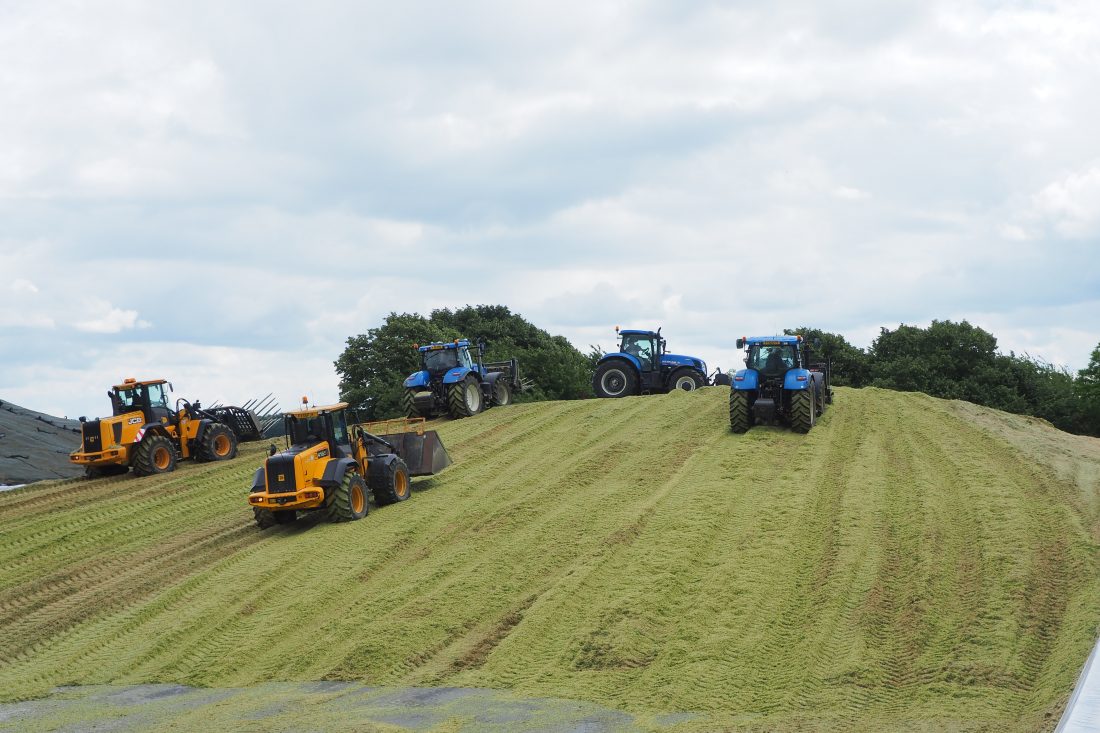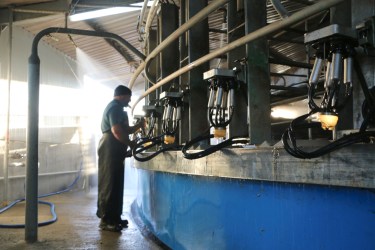By Andrew Hawkins
I am often met with a sceptical look when I review a poorly managed clamp and suggest a whole quarter of the silage ensiled has been lost. The reason it is hard to believe losses are this big is that they can’t be seen. Material disappears silently and mysteriously as methane and carbon dioxide leak into the atmosphere. But these losses do occur and are the outcome when the management of packing, covering and removing silage is poor. With proper management, this level of waste can be cut in half.
Silage losses
A herd of 200 cows consuming 12Kg DM per day over a six-month winter will eat 438 tonnes of dry matter. If 25% of material grown is wasted 584 tonnes needs to be ensiled to achieve the amount needed. Reducing this waste level down to 12.5% will save 84 DM tonnes of silage. This saving could mean more cows can be kept, less bought-in feed, less rented keep or a bigger reserve for the year when production is hit by a drought.
The other issue with silage spoiled by excess heating and the digestion of lactic acid by yeasts and moulds is that protein will degrade. The energy value will reduce, and the mycotoxin load will increase. Neither outcome is favourable to supporting a healthy, productive cow. Rather than solving this problem with expensive concentrates or additives, it is far better to stop the problem occurring in the first place.
Losses from wastage, reduction in feed value and subsequent remedial treatments could easily add up to per cow through additional costs and lower production. As the example below shows, a herd could be losing at least £26,000 by not addressing this issue effectively.
| Loss of 1 litre per day 180 D * 30ppl | Additional silage needed (0.42 TDM)@£100/TDM | Feed additives, protein replacement and additional concentrate 21p/day | Total value lost £/cow (200 cow herd) |
| £54 | £42 | £38 | £134 (£26,800) |
The difference in losses in silo management are largely as a result of aerobic microbial activity often referred to as aerobic spoilage. Our focus used to be on fermentation problems but this is less of an issue in practice providing high sugar grasses are used, an effective additive is applied, and the material ensiled isn’t excessively wet.
What appears to be far more of an issue today is unstable silage caused by air penetrating the face, walls and top of the clamped material. Ironically, the better we become at preserving and wilting grass, the worse we seem to be at holding back spoilage organisms.
Wastage gets worse with increased numbers of microorganisms (yeasts, moulds, bacteria; increased oxygen content(air); increased substrate (carbohydrate and lactic acid); and in low moisture (dry silage). Anything limiting these factors will reduce this loss of valuable feed.
Heat is the great multiplier of aerobic spoilage. It causes gasses in the clamp to rise and leak away, sucking in more air, causing a chain reaction of higher growth of the spoilage microorganisms and even more material to be lost. Visibly mouldy silage is a sign of spoilage but represents the tip of the iceberg of cumulative losses. No one seems to notice the shrinking clamp or realises the impact on feed value.
How to avoid silage losses
Reducing air spaces in the clamp is the leading tactic operators can employ to minimise the movement of gasses within a clamp. If all air is removed, the material will have a porosity of 0. The difference between this level and the amount of room the same material occupies before the gasses are removed is referred to as porosity and equals the volume represented by gasses. The aim should be to reduce porosity to 40% or less.

We use the excellent spoilage calculator developed by Brian Holmes and Richard Muck from the U.S. Dairy Forage Research Centre at the University of Wisconsin Madison, to estimate the ideal level of packing needed to achieve stable silage. The variables of the crop cut length, dry matter content, filling rate, storage height, packing (tractor) weight and packing time are entered into the calculator which predicts the level of porosity of the clamped material.
I’ve worked out the impact of measures you should employ at the ensiling time to achieve porosity below 40%. They are shown in isolation, but steps can be combined to achieve the desired effect. The amount of packing weight is 3X greater with material of 35% dry matter compared to 25%. Reducing the height of the material stack by one metre requires around 10% more packing weight (Graph A). Building up the clamp in shallow layers is the most effective tactic for reducing porosity. Graph B shows a 10cm layer of 35% DM silage requires 30 tonnes less packing weight than a 20cm layer. The most powerful self-propelled harvesters can achieve spot work rates of 400 TPH. As Graph D shows, this requires really high levels of packing to achieve the desired level of porosity. However, providing shallow layers are packed; it is possible to achieve the desired level of consolidation with two large wheeled machines.
There is no sense in using low-pressure flotation tyres, dual wheels or rollers. These machines spread weight when the opposite of concentrating weight is desired.

Silage management do’s and dont’s
With milk prices under pressure, there is an immediate need to try and find savings and increase income. However, as with many other activities on farms, the impact of management today if often not realised for months ahead. Nonetheless, the reward for getting it right, as I’ve shown is substantial. In practical terms here are some do’s and dont’s I advocate with my clients to help with optimising clamp management.
| Do’s | Dont’s |
| -Aim to keep below 35% DM (30% is better) -Build-up in small layers -Have enough tractor weight in relation to fill speed -Focus on compacting against sides and walls -Maximum slope of the heap should be 30 degrees -Finish rolling at the end of the day (sheeting is unnecessary) -Sheet with two layers of plastic – protect from birds -Weigh sheet down -Fast face removal -Use a sharp shear grab or facer to unload | -Try to ensile dry material above 35% DM -Build-up in clumps -Use Dual wheels, rollers or flatteners -Fill faster than you can compact -Steep side walls are unsafe and cannot be compacted -Roll in the morning before filling starts (it sucks in oxygen) -Leave clamp walls unsheeted unless they are adequately sealed -Allow sheet to bellow – this will suck in oxygen -Slow face removal -Unload with a bucket |








